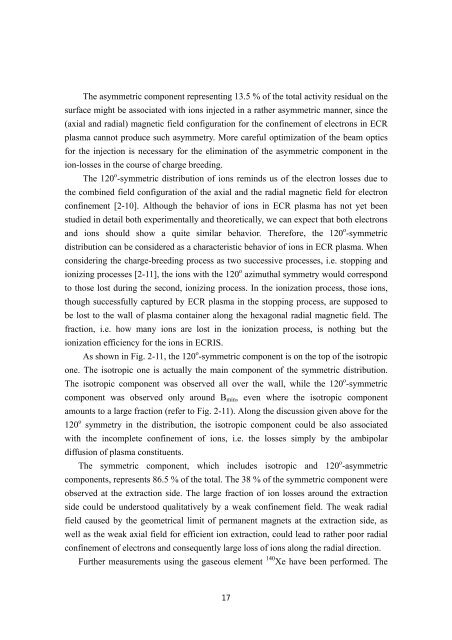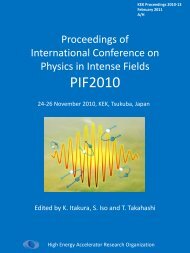TRIAC Progress Report - KEK
TRIAC Progress Report - KEK
TRIAC Progress Report - KEK
Create successful ePaper yourself
Turn your PDF publications into a flip-book with our unique Google optimized e-Paper software.
The asymmetric component representing 13.5 % of the total activity residual on the<br />
surface might be associated with ions injected in a rather asymmetric manner, since the<br />
(axial and radial) magnetic field configuration for the confinement of electrons in ECR<br />
plasma cannot produce such asymmetry. More careful optimization of the beam optics<br />
for the injection is necessary for the elimination of the asymmetric component in the<br />
ion-losses in the course of charge breeding.<br />
The 120 o -symmetric distribution of ions reminds us of the electron losses due to<br />
the combined field configuration of the axial and the radial magnetic field for electron<br />
confinement [2-10]. Although the behavior of ions in ECR plasma has not yet been<br />
studied in detail both experimentally and theoretically, we can expect that both electrons<br />
and ions should show a quite similar behavior. Therefore, the 120 o -symmetric<br />
distribution can be considered as a characteristic behavior of ions in ECR plasma. When<br />
considering the charge-breeding process as two successive processes, i.e. stopping and<br />
ionizing processes [2-11], the ions with the 120 o azimuthal symmetry would correspond<br />
to those lost during the second, ionizing process. In the ionization process, those ions,<br />
though successfully captured by ECR plasma in the stopping process, are supposed to<br />
be lost to the wall of plasma container along the hexagonal radial magnetic field. The<br />
fraction, i.e. how many ions are lost in the ionization process, is nothing but the<br />
ionization efficiency for the ions in ECRIS.<br />
As shown in Fig. 2-11, the 120 o -symmetric component is on the top of the isotropic<br />
one. The isotropic one is actually the main component of the symmetric distribution.<br />
The isotropic component was observed all over the wall, while the 120 o -symmetric<br />
component was observed only around Bmin, even where the isotropic component<br />
amounts to a large fraction (refer to Fig. 2-11). Along the discussion given above for the<br />
120 o symmetry in the distribution, the isotropic component could be also associated<br />
with the incomplete confinement of ions, i.e. the losses simply by the ambipolar<br />
diffusion of plasma constituents.<br />
The symmetric component, which includes isotropic and 120 o -asymmetric<br />
components, represents 86.5 % of the total. The 38 % of the symmetric component were<br />
observed at the extraction side. The large fraction of ion losses around the extraction<br />
side could be understood qualitatively by a weak confinement field. The weak radial<br />
field caused by the geometrical limit of permanent magnets at the extraction side, as<br />
well as the weak axial field for efficient ion extraction, could lead to rather poor radial<br />
confinement of electrons and consequently large loss of ions along the radial direction.<br />
Further measurements using the gaseous element 140 Xe have been performed. The<br />
17













